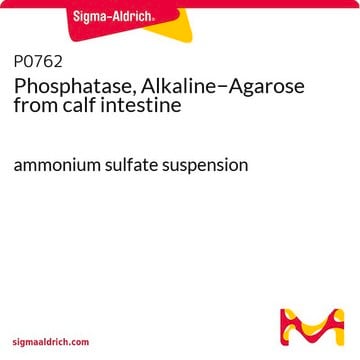API-RO
Roche
Alkaline Phosphatase (AP)
grade I, from calf intestine
Sinónimos:
AP, Alkaline Phosphatase
Seleccione un Tamaño
$138.00
Disponible para envío el31 de marzo de 2025Detalles
Seleccione un Tamaño
About This Item
$138.00
Disponible para envío el31 de marzo de 2025Detalles
Productos recomendados
origen biológico
bovine (calf) intestine
Nivel de calidad
Formulario
suspension
envase
pkg of 1,500 U (10108138001)
pkg of 7,500 U (10108146001)
fabricante / nombre comercial
Roche
pH óptimo
8.0-10.5
Absorción
7.6 at 278 nm (10 mg AP/ml)
temp. de almacenamiento
2-8°C
Descripción general
Alkaline phosphatase catalyzes the removal of phosphate group from various compounds that are phosphorylated.[1] It hydrolyzes 5′-monophosphate groups from both DNA and RNA. It can also hydrolyze 5′-diphosphate and 5′-triphosphate groups from RNA.
Especificidad
Denaturation is dependent on protein concentration - using less than 10 U/ml (0.1 mol/l glycine buffer, pH 10.5, 1 mmol/l MgCl2 and 0.1 mmol/l ZnCl2), AP is inactivated by a 10 minutes incubation at 65 °C.
Aplicación
Calidad
Secuencia
In some mammals (e.g., humans), there are at least 3 distinguishable isoenzymes: the intestinal, the placental and the form found in bone/liver/kidney.
Definición de unidad
AP activity is not expressed in Armstrong units; a conversion factor for international units is not known.
Approx. 3.8 U (grade I AP) or 4.0 U (grade II AP) [+37 °C, 4-NPP as substrate, diethanolamine as buffer, pH 9.8] = 1 U [+25 °C, 4-NPP as substrate, glycine as buffer, pH 10.5].
Biochemica Information. 87 (grade I AP) :
1.0 U [+37 °C, QC assay conditions] = 0.79 U [+30 °C, QC assay conditions] = 0.57 U [+25 °C, QC assay conditions]
Forma física
Nota de preparación
- Activator: Divalent metal ions (Mg2+, Co2+, Mn2+)
- Amino alcohols (2-amino-2-methyl-1-propanol, diethanolamine)
Note that high concentrations of amino alcohols can as well act as competitive inhibitors (e.g., monoethanolamine in diethanolamine).
Storage conditions (working solution): The suspension is offered at a c= approx. 5 mg/ml.
If this suspension is diluted only 5 to 10-fold with further 3.2 M ammonium sulfate solution, 1 mM MgCl2, 0.1 mM ZnCl2, pH approx. 7, we would expect from general experience that a stability for some weeks might be given provided it is stored at 4 °C (no guarantee!).
Otras notas
Código de clase de almacenamiento
12 - Non Combustible Liquids
Clase de riesgo para el agua (WGK)
WGK 1
Punto de inflamabilidad (°F)
does not flash
Punto de inflamabilidad (°C)
does not flash
Elija entre una de las versiones más recientes:
¿Ya tiene este producto?
Encuentre la documentación para los productos que ha comprado recientemente en la Biblioteca de documentos.
Los clientes también vieron
Protocolos
Alkaline phosphatase (AP) is a non-specific phosphomonoester hydrolase that catalyzes the hydrolysis of a wide variety of organic monophosphates.
Nuestro equipo de científicos tiene experiencia en todas las áreas de investigación: Ciencias de la vida, Ciencia de los materiales, Síntesis química, Cromatografía, Analítica y muchas otras.
Póngase en contacto con el Servicio técnico






